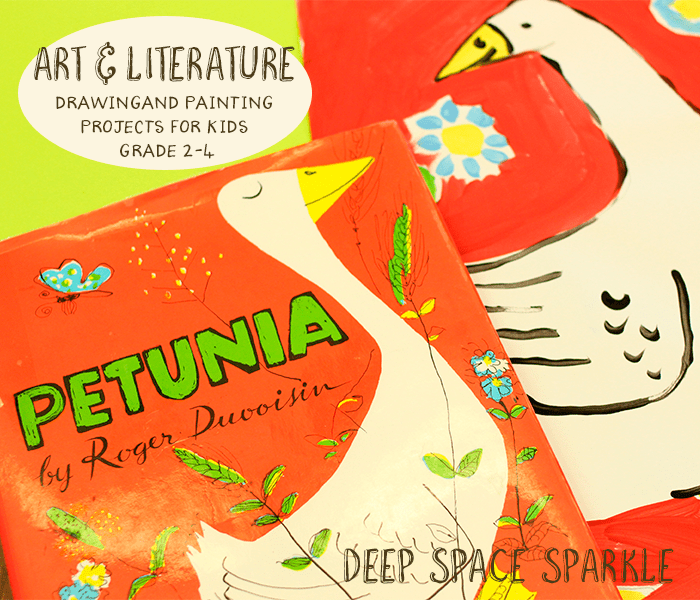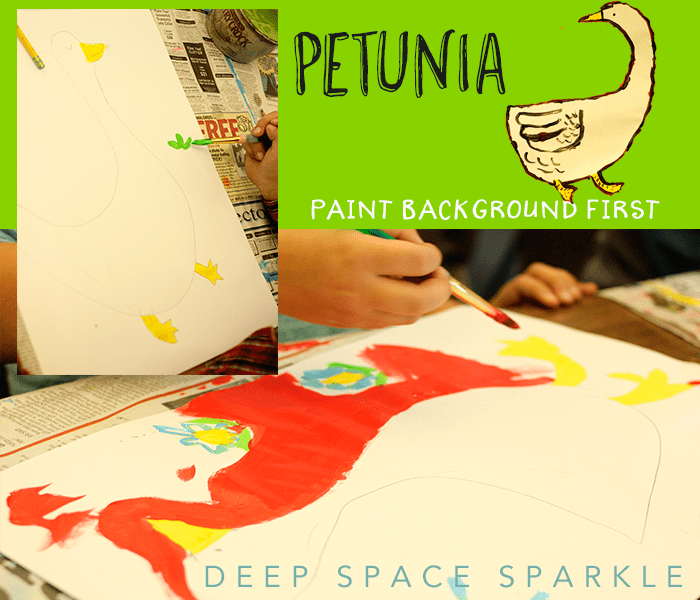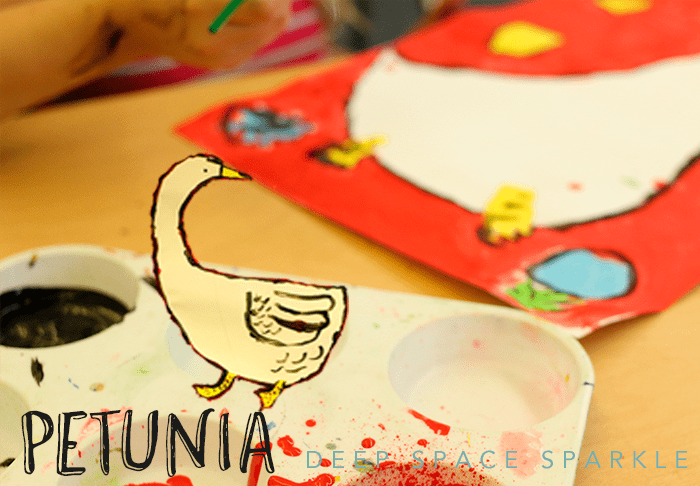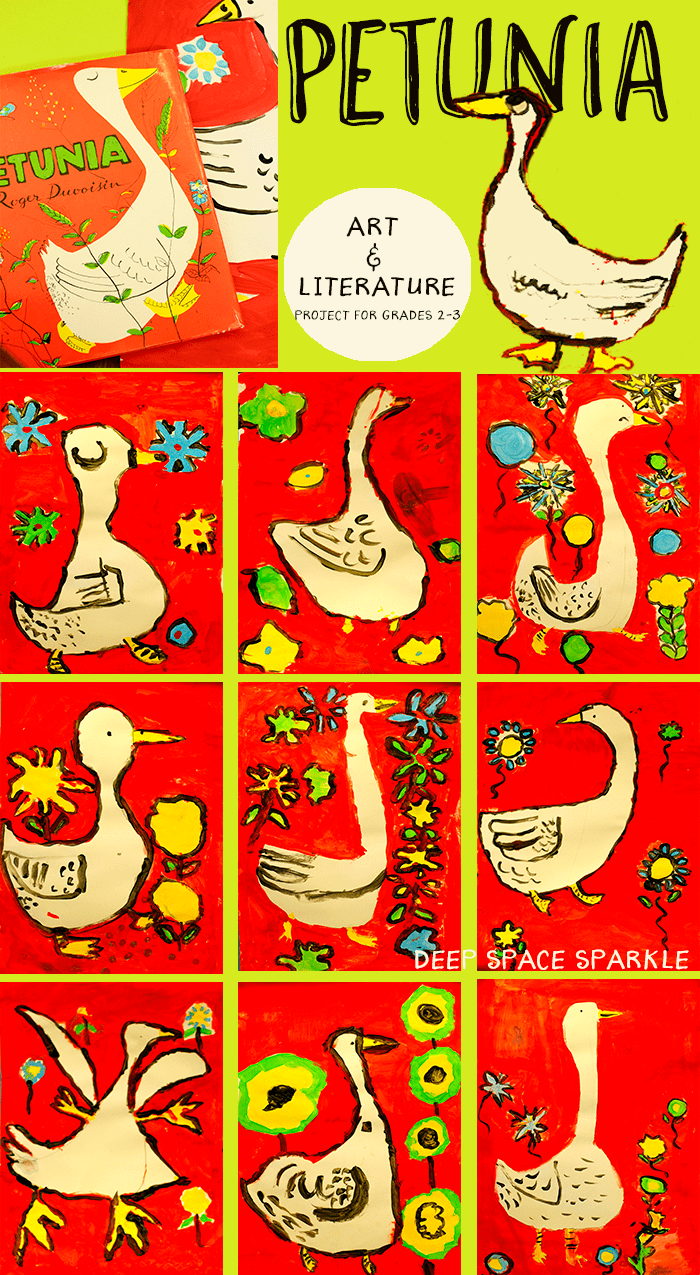“PETUNIA” PAINTING PROJECT FOR KIDS

Incorporating literature into art projects remains my favorite type of lesson. Last year, I introduced Petunia to my third grade students. Using a painting project technique that I call smoothing, my students sketched a goose with pencil then painted with happy colors, just like the book.
Don’t have the book? You can download this delightful video found on YouTube:
WHAT YOU’LL NEED:
- 12″ x 18″ white sulphite paper
- Pencil and Eraser
- Red, yellow, white, blue, green and black liquid tempera paint (I use Crayola)
- I medium tip round brush
- 1 small tip round brush (for outlining)
- Black marker, black crayon or lack oil pastel as optional outing supplies.
DRAWING
I photocopied a few pages from the book and placed on the children’s tables. Using observation techniques, the kids practiced drawing their own Petunia. I encouraged them to make a dot near the top of the paper and one near the bottom. The dots provided guidelines for where to start the head and where to place the feet. This ensures the goose will be drawn large enough to fill most of the paper.


PAINTING
Once the drawing was complete, children dipped a medium paint brush in the red paint and painted sections of the background paper. We used the smoothing technique to achieve a smooth paint finish. The children carefully painted around Petunia and the spring flowers.
After the background was complete, the children painted the flowers and leaves with a collection of green, yellow and blue paint mixed with small amounts of white. This created TINTS and resembled the illustrations found in the book.
OUTLINING
Once the paint is dry, children can use a small pointed brush dipped in watered-down black paint to outline Petunia. Notice how the children didn’t paint Petunia white? The white paper offered enough contrast so that painting the goose white seemed unnecessary. Although, children can paint their goose if they wish.
If you don’t like to use black paint to outline, you can use a thick black marker or even a crayon. Experiment and see what medium works best for you.














Please describe the “smoothing technique”. Thank you
Sure! I not only explain, but I show it in the video. Click on SMOOTHING TECHNIQUES in the post (it’s in bold).
Hi Patty! Would you mind linking the You Tube video for me please or emailing me the link? My school blocks the video 🙁
So sweet:)
Can’t wait to try this!
I am now a member, however, I cannot seem to find the place that is just for members. Could you please instruct me how to do that so that I can find lessons, etc.
Thanks,
Peggy Huhn
Hi Peggy,
Yes you seemed lost down the DSS rabbit hole!
You can login on this page: https://www.sparklersclub.com/tsc/learn-about-the-members-club/
Then you can bookmark the page plus access the page from you DSS Orders page. Welcome!
Patty you’re amazing!
Thank you Patty. I love the story. The question I have, do the children draw Petunia with a pencil first, or do they draw with a coloured pastel? Often I ask the kids to draw straight with the black pastel.
You could do either with 3rd grade. Because I wanted to replicate the illustrations in the book, we used pencil. But drawing with oil pastel is a preferred method of mine as it encourages children o draw bigger. You can choose a lighter oil pastel color…perhaps yellow.
I love it. I work with childeren who are just seven or even still six years old. Is this petunia a possibility for them? I live in Holland and i don’t really understand the grades you speak about. Which age belongs to which grade?
greetings Marleen
I think that looks great…..and thanks for the smoothing technique1
I can’t believe you have an art lesson featuring “Petunia”!! My mother gave this book to my children a few years ago and I had never heard of it but we absolutely love it. We read it again last night and never tire of it’s wit, wisdom and fantastic illustrations. Can’t wait to explore the smoothing technique with my kids!
I’m so glad you like this book…isn’t it the cutest? And this project was so fun for the kids.
great thanks so much for including the video of the story and your smoothing technique so glad I found your site
I love your work and I want to try it with my kids. Thank you
Thank-you so much for this! My students enjoyed it and did so well! I showed them the story video from this post as well and they loved it. 🙂
amazing technique to teach the little ones.
Love it.
I am so excited to see you have a Petunia project! My Grandpa used to read this to me as a little girl. I just love the story and still have the old worn copy he would read. I’m excited to share the story and the project with my first and second graders!
My grandma bought me this book when I was young and I still have it. I wish that I still was teaching so that I could use this lesson…maybe someday soon!